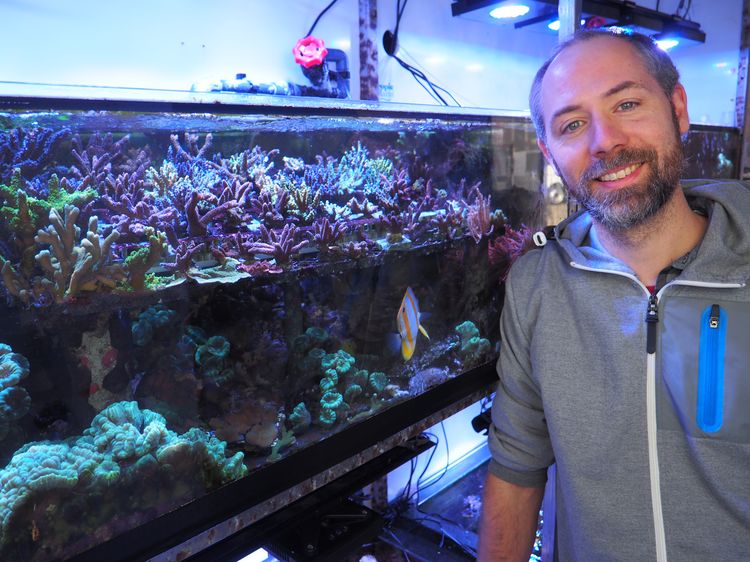
Dr. Matthias Kellermann
Schleusenstrasse 1
26382 Wilhelmshaven
+49 4421 944 215
Analytical Infrastructure
Sample Preparation and Analytical Infrastructure
In addition to the tropical aquarium facility for ecological experiments and experiments on coral propagation, chemical analysis is another pillar in the Environmental Biochemistry working group. The analysis of various organic molecules from marine organisms and their associated microbiome requires specialized procedures for sample preparation and purification and, most importantly, high-quality instrumentation for the identification and quantification of bioactive target compounds. Here, for example, we can chemically separate bioactive secondary metabolites from a wide variety of marine organisms using preparative high performance liquid chromatography (prep-HPLC, Agilent 1260 Infinity) and identify these molecules using high-resolution mass spectrometers (HRMS, WATERs Q-ToF Synapt G2-Si) and quantify them accurately down to trace amounts (WATERs TQ-S XEVO Micro). Below, we describe our state-of-the-art analytical infrastructure in more detail.
Preparative HPLC for compound purification
The Agilent HPLC (1260 Infinity) equipped with a DAD (Diode Array Detector) and ELSD (Evaporative Light Scattering Detector) is a powerful analytical system for separating, detecting, and quantifying complex mixtures of organic compounds.
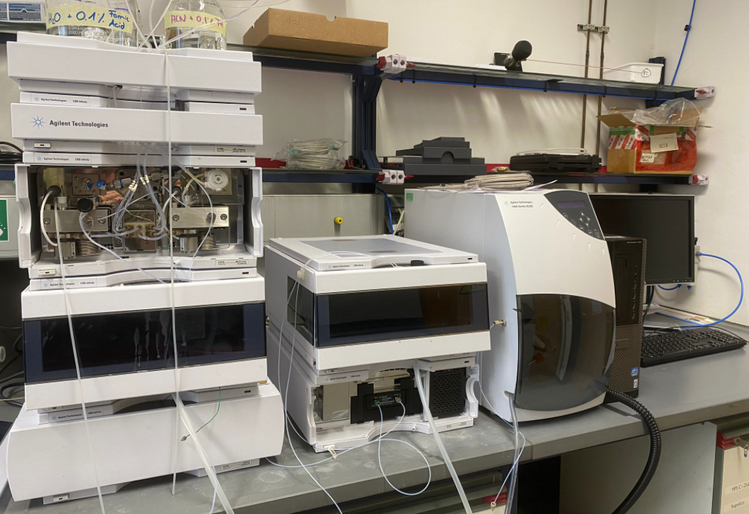
The Agilent GC (1260 Infinity) equipped with a DAD (Diode Array Detector) and ELSD (Evaporative Light Scattering Detector)
The DAD is a UV-Vis detector that uses a diode array to detect and quantify multiple components in a single run. It can detect a wide range of compounds, including non-chromophoric and semi-volatile compounds, and has a linear dynamic range of up to 4 orders of magnitude. The benefits of using a DAD include: (1) higher sensitivity and specificity compared to conventional UV detectors (2) ability to perform spectral analysis for identification and confirmation of compounds (3) possibility of performing quantitative analysis using multiple wavelengths
The ELSD is a universal detector that can detect a wide range of compounds, including non-volatile and non-chromophoric compounds that are not detected by UV detectors. It works by evaporating the mobile phase and detecting the scattered light from the sample. The benefits of using an ELSD include: (1) higher sensitivity and specificity compared to refractive index detectors (2) universal detection, regardless of the chemical nature of the analyte (3) low limit of detection and high dynamic range.
Gas chromatography coupled to mass spectrometry
Gas chromatography coupled to mass spectrometry combines two separate analytical techniques to provide highly accurate and detailed information about the compounds in a sample. GC enable the separation of organic molecules, from small gaseous molecules to compounds containing a much higher number of carbon atoms, such as polychlorinated biphenyls (PCBs), hexachlorobenzene (HCBs), hexachlorocyclohexane (HCH) and dichlorodiphenyltrichloroethane (DDT). The Agilent 6890 Series GC is a versatile and reliable GC that is capable of handling a wide range of samples, from trace analysis to high throughput applications. Some benefits of using a GC include: (1) high separation efficiency and resolution (2) excellent reproducibility and accuracy (3) ability to handle a wide range of sample types and matrices.
When attached to a MS it offers the identification of molecular structures and simultaneous can provides information on the concentration of a target analyte. The single quadrupole benchtop Agilent GC-MS containing a 6890 GC and a 5973 MSD is the "work-horse" instrument in our group for characterizing GC-amenable organic contaminants and pesticides. It is operating in EI mode only and has a full scan capacity from m/z 2 to 800 Dalton. The Agilent 5973 MSD is a robust and reliable detector that is widely used in the analysis of complex mixtures. Some benefits of using an MSD include: (1) high sensitivity and selectivity (2) ability to identify compounds based on their mass spectra (3) possibility of performing quantitative analysis using selected ion monitoring (SIM).
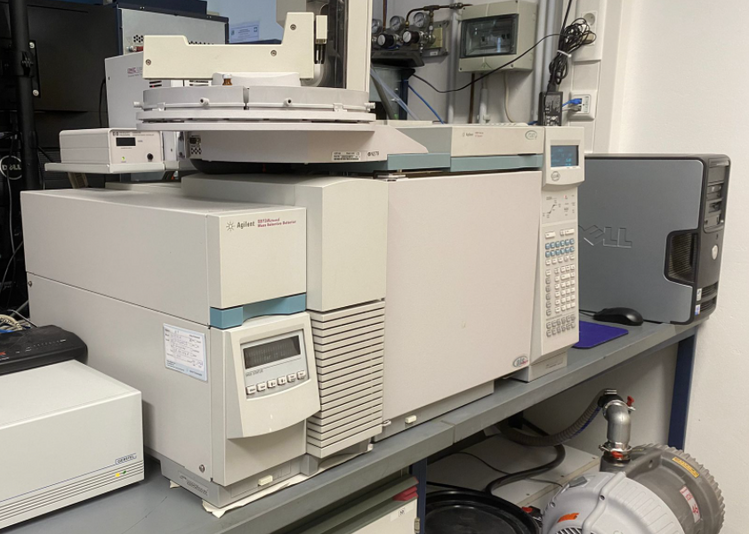
The Agilent GC (6890 Series) MSD (5973) is a powerful analytical system that combines the high separation efficiency and reproducibility of the GC with the high sensitivity and selectivity of the MSD.
Liquid chromatography coupled to mass spectrometry (LC-MS)
Liquid chromatography coupled to mass spectrometry (LC-MS) is used for the identification of polar, high molecular weight organic compounds and enables semi-quantitative determination of concentrations. In the Environmental Biochemistry Group, LC-MS techniques are mainly employed for the characterization of the metabolome derived from marine organisms and their associated microbiome.
When LC and MS are combined, the LC-MS system offers several benefits, such as: (1) improved sensitivity and specificity compared to LC or MS alone (2) ability to identify unknown compounds based on their mass spectra (3) possibility of performing quantitative analysis using SIM or multiple reaction monitoring (MRM) (4) compatibility with a wide range of sample types and matrices, including biological fluids, environmental samples, and complex mixtures.
Overall, LC-MS is a powerful and versatile technique that offers high sensitivity and specificity for the separation, identification, and quantification of a wide range of organic compounds in complex mixtures.
SYNAPT G2-Si Mass Spectrometry
The SYNAPT G2-Si Mass Spectrometry (Waters) is a hybrid quadrupole mass spectrometer with ion mobility and orthogonal acceleration (Q-ToF) that combines high-resolution mass spectrometry (HRMS) with highly efficient ion mobility-based (IMS) measurements and separations. It can be either equipped with a dual-orthogonal API source (LockSpray™ ESI/APCI) or a matrix-assisted laser desorption/ionization (MALDI) ion source. In routine mode the SYNAPT is connected to a Waters ACQUITY UPLC H-Class system to screen metabolites in solution or optional an imaging method (MALDI Imaging Mass Spectrometry for short) for the analysis of chemical components and their spatial distribution within a sample.
Here are some features and advantages of this instrument: (1) high-resolution mass measurement, which allows for the detection and identification of even minor components in complex mixtures. The accurate mass measurement also enables the determination of elemental compositions, which is useful for identifying unknown compounds. (2) this instrument is equipped with ion mobility separation, which separates ions based on their size, shape, and charge. This allows for an additional dimension of separation, which can improve the specificity and accuracy of compound identification. (3) the instrument offers a range of fragmentation techniques, including collision-induced dissociation (CID), electron-transfer dissociation (ETD), and beam-type collision-induced dissociation (HCD). These techniques provide different types of fragmentation information, which can be used for structural characterization and identification of unknown compounds. (4) the SYNAPT G2-Si Mass Spectrometry provides high sensitivity, which enables the detection of even trace amounts of compounds in complex mixtures. (5) the instrument offers data-independent acquisition (DIA) mode, which provides comprehensive and reproducible data for label-free quantitative analysis. DIA mode also enables the detection of low-abundance analytes and the identification of co-eluting isobaric compounds.
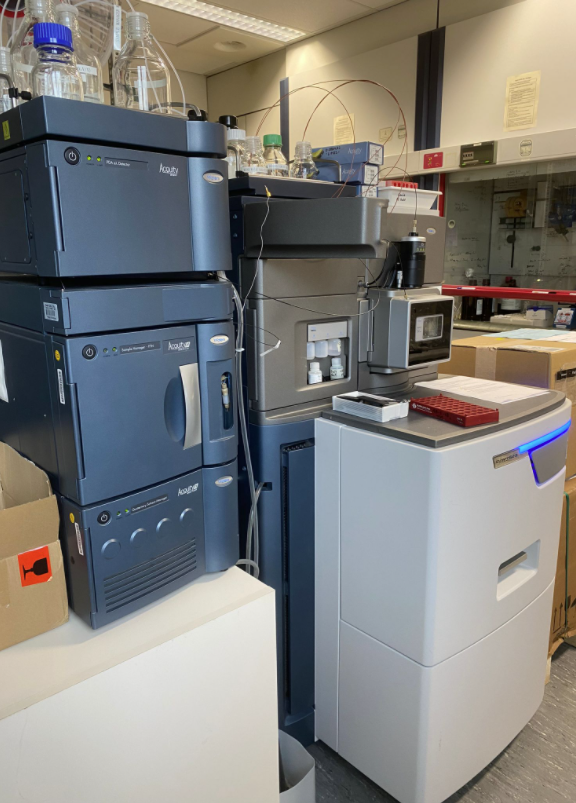
SYNAPT G2-Si Mass Spectrometry is well-suited for a wide range of applications, including metabolomics, lipidomics, and small molecule analysis.
Xevo TQ-S micro triple quadrupole mass spectrometry
The Xevo TQ-S micro triple quadrupole mass spectrometry (Waters) is a highly sensitive and selective instrument used for the quantitative analysis of small molecules and biomolecules. This compact, high performance work horse is fast, reliable and delivers consistently low quantitation values with a wide dynamic range. Here are some features and benefits of this instrument: (1) the triple quadrupole technology, consisting of two mass filters and a collision cell, allows for highly selective and sensitive detection of target compounds in complex matrices. (2) multiple reaction monitoring (MRM) mode allows for highly specific and sensitive detection of target compounds in complex matrices. This mode also enables the detection of low-abundance analytes and the identification of co-eluting isobaric compounds. (3) the high sensitivity and dynamic range enables the detection and quantification of trace amounts of compounds in complex matrices. This makes it an ideal tool for our ecotoxicological project on the effects of UV filters on corals. (4) the rapid scan rate allows for high-throughput analysis of samples without sacrificing sensitivity or selectivity.
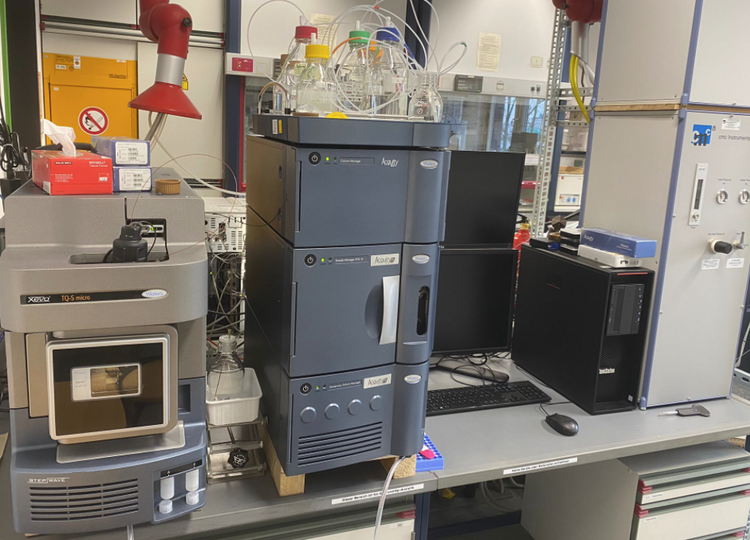
The Xevo TQ-S micro triple quadrupole mass spectrometry is a highly sensitive and selective instrument that is well-suited for a wide range of applications, including ecotoxicological screening drug discovery, and environmental analysis.
Synergy H1 Hybrid Multi-Mode Reader
The Synergy H1 Hybrid Multi-Mode Reader is a microplate reader designed for various applications such as absorbance, fluorescence, and luminescence assays. BioTek Synergy H1 is a modular multimode microplate reader, with monochromator-based optics and filter-based optics. The patented Hybrid Technology offers flexibility and sensitivity across a broad range of applications. The modular platform allows upgrading to expand functionality as your laboratory workflows change. Synergy H1 offers continuously variable bandwidth monochromators for fluorescence excitation and emission wavelength selection. Fluorescence bandwidth can be set between 9 and 50 nm, in 1 nm increments, allowing users to fully optimize reader settings to drive the best assay performance compared to fixed bandwidth systems. Overall, the BioTek Synergy H1 is a versatile and reliable microplate reader that is widely used in various research fields, including drug discovery, molecular biology, and biochemistry.
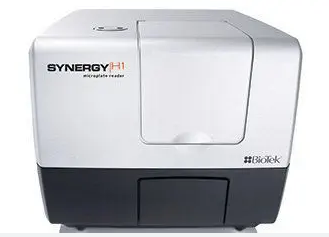
The BioTek Synergy H1 is a microplate reader designed for various applications such as absorbance, fluorescence, and luminescence assays.
Direct Mercury Analyzer
The DMA-80 mercury (Hg) analyzer (Direct Mercury Analyzer) is used for the quick and easy determination of Hg in solid or liquid samples. In our group, we study Hg storage in bird eggshells, bird embryos, bird feathers, fish and their organs, as well as sediment samples. Therefore, the weight of the samples is determined by the integrated analytical balance of the DMA-80. Sequential processing of the samples is performed by an automatic sampler. The analysis per sample takes between 6 and 7 minutes.
Method of operation: The sample is decomposed with oxygen at high temperatures, the released Hg is bound to an amalgam collector, then atomized and measured with the built-in atomic absorption spectrometer.
Hg detection range: In our group, Hg levels are determined in the range of 0.05 ng to 50 ng. Theoretically, the DMA80 can measure Hg levels from 0.001 ng to 1000 ng.
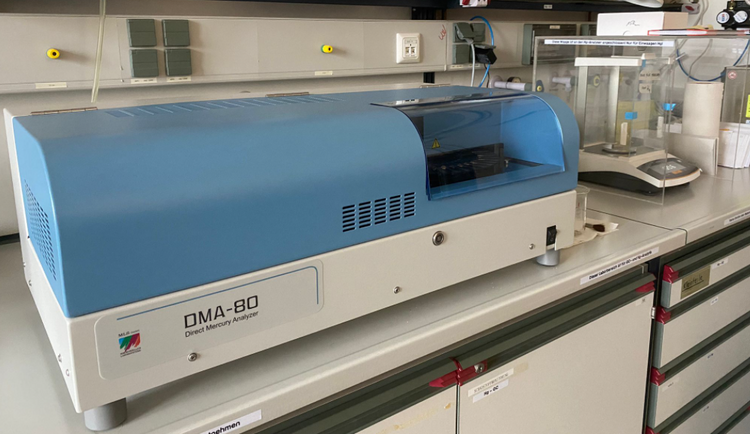 The Direct Mercury Analyzer (DMA) is used for the quick and easy determination of Hg in the range of 0.05 ng to 50 ng.
The Direct Mercury Analyzer (DMA) is used for the quick and easy determination of Hg in the range of 0.05 ng to 50 ng.

![[Translate to English:]](/f/5/_processed_/3/2/csm_ICBM-Logo-transparent-_91fe1c6774.png)